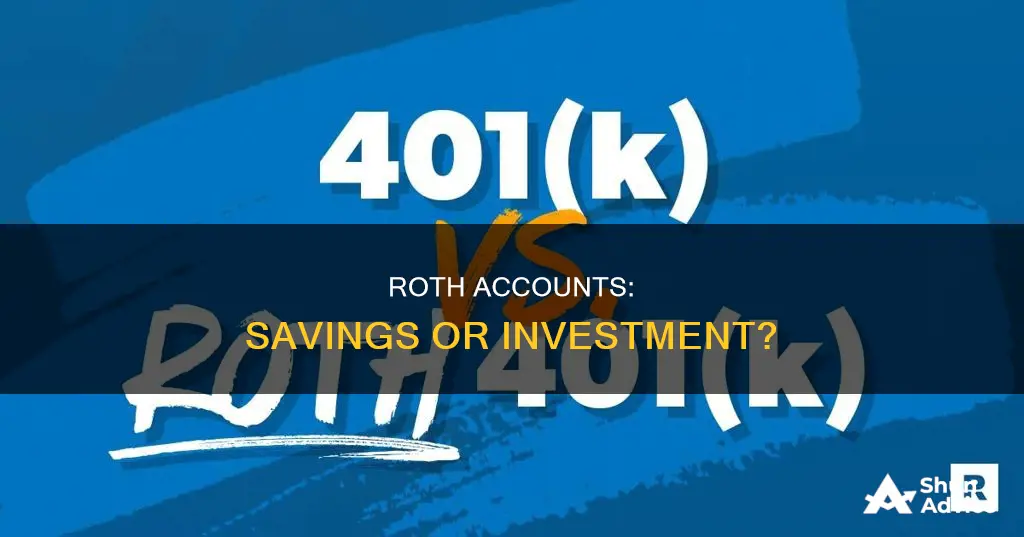
A Roth IRA is a type of individual retirement account that lets you contribute after-tax money to save for retirement. The main draw of a Roth IRA is that the money grows tax-free and can be withdrawn tax-free after age 59 ½ as long as the account has been open for at least five years. The main difference between a Roth IRA and a traditional IRA is how it's taxed. In a traditional IRA, contributions are tax-deductible in the year they're made, but withdrawals in retirement are taxed.
| Characteristics | Values |
|---|---|
| Type of account | Individual retirement account (IRA) |
| Taxation | After-tax dollars |
| Withdrawals | Tax-free after 59 1/2 years old and 5 years after opening the account |
| Contribution limits | $7,000 in 2024 ($8,000 for those 50 or older) |
| Accessibility | Accessible anytime |
| Flexibility | Can be used for any purchase |
| Investment options | Stocks, ETFs, Bonds, Savings accounts, Money market accounts, CDs, Real estate, Cryptocurrencies, Promissory notes, tax lien certificates, private placement securities |
| Tax advantages | Tax-free growth and withdrawals in retirement |
| Required minimum distributions (RMDs) | No RMDs |
What You'll Learn

Roth IRAs are a type of individual retirement account
A Roth IRA is a type of individual retirement account (IRA) that allows you to contribute after-tax money towards your retirement savings. This means that you pay taxes on the money going into your account, and then all future withdrawals are tax-free once you reach the age of 59½ and have held the account for at least five years.
Roth IRAs are similar to traditional IRAs, but the main difference lies in how they are taxed. With a traditional IRA, contributions are often tax-deductible, meaning you don't pay taxes upfront, but withdrawals in retirement are taxed as ordinary income. In contrast, Roth IRAs are funded with after-tax dollars, so you pay taxes on the money going in, but withdrawals are tax-free in retirement. This makes Roth IRAs ideal if you expect your marginal tax rate to be higher in retirement than it is currently.
Another advantage of Roth IRAs is that they do not have required minimum distributions (RMDs) during the account holder's lifetime, unlike traditional IRAs and 401(k) plans. This means that you can leave your money in the Roth IRA indefinitely and let it continue to grow tax-free. Additionally, you can withdraw your original contributions from a Roth IRA at any time without penalties or taxes, as you've already paid income tax on this money.
When it comes to investment options, Roth IRAs offer a variety of choices, including stocks, mutual funds, bonds, exchange-traded funds (ETFs), certificates of deposit (CDs), and money market funds. However, life insurance and collectibles are not allowed as investments within a Roth IRA.
In terms of income limits, the ability to contribute to a Roth IRA is phased out at higher incomes. For 2024, the contribution limit is $7,000, or $8,000 if you're 50 or older, and there are income thresholds above which contributions are reduced or not allowed.
Overall, a Roth IRA can be a powerful tool for retirement savings, offering tax-free growth and withdrawals, no RMDs, and flexible investment options.
Certificate of Deposit: Investment or Savings?
You may want to see also

You can withdraw contributions from a Roth IRA at any time without penalty
A Roth IRA is a type of individual retirement account (IRA) that allows you to withdraw money (without paying a penalty) on a tax-free basis after age 59½ and after you have owned the account for its five-year holding period. You can withdraw contributions from a Roth IRA at any time without tax implications or penalties. This is because contributions are made with after-tax dollars, so you've already paid income tax on that money.
However, if you withdraw more than you've contributed, you may be subject to taxes and penalties on the earnings portion of the withdrawal. To withdraw earnings tax- and penalty-free, your account must have been open for at least five years, and you must be at least 59½ years old.
There are some exceptions to the five-year rule and the age requirement. For example, you can make a penalty-free withdrawal if the money is being used for a first-time home purchase, qualified education expenses, or unreimbursed medical expenses.
It's important to note that while you can withdraw contributions from a Roth IRA at any time, you generally can't redeposit the money if you change your mind. There is an exception that allows you to take a short-term loan from your IRA if you redeposit the money within 60 days, but this can only be done once a year.
Graph Savings: A Smart Investment Strategy?
You may want to see also

There are no required minimum distributions for Roth IRAs
Roth IRAs are a type of tax-advantaged individual retirement account (IRA) that allows you to contribute after-tax dollars toward your retirement. Unlike traditional IRAs, there are no required minimum distributions (RMDs) for Roth IRAs during the account owner's lifetime. This means that you don't have to take any distributions from a Roth IRA while you are alive. Instead, you can leave the funds in the account to grow tax-free and pass them on to your heirs.
The lack of RMDs for Roth IRAs offers several benefits. Firstly, it allows you to keep your retirement savings untouched and growing tax-free for as long as you live. This can be especially advantageous if you don't need the money from your Roth IRA for living expenses. Secondly, it provides flexibility, as you are not required to withdraw a certain amount each year. This means you can choose to leave your money in the account and let it grow, or withdraw funds as needed without any mandatory distribution rules.
While there are no RMDs for Roth IRAs during the account owner's lifetime, beneficiaries of a Roth IRA are generally required to take RMDs. However, there is an exception for spouses, who can treat the inherited Roth IRA as their own and follow the same distribution rules as the original account holder.
It's important to note that designated Roth accounts in a 401(k) or 403(b) plan were subject to RMD rules for 2022 and 2023. However, starting in 2024, RMDs are no longer required from these designated Roth accounts.
In summary, Roth IRAs offer the advantage of no RMDs during the account owner's lifetime, providing the flexibility to leave funds in the account untouched and growing tax-free. However, beneficiaries of a Roth IRA will generally need to take RMDs, with some exceptions for spouses.
Smart Ways to Invest Your RBFCU Savings
You may want to see also

You can invest in a variety of securities with a Roth IRA
A Roth IRA is a type of tax-advantaged individual retirement account (IRA) that allows you to contribute after-tax money to save for retirement. The main draw of a Roth IRA is that the money grows tax-free and can be withdrawn tax-free after age 59 1/2 as long as the account has been open for at least five years.
- Mutual Funds: Mutual funds are professionally managed investment funds that offer simplicity, low expenses, and diversification. They are a good option for those seeking a hands-off approach to investing.
- Stocks: Stocks, also known as equities, represent ownership in a company. Investing in stocks can provide growth potential, but it also comes with higher risk.
- Bonds: Bonds are debt securities that are issued by governments, municipalities, and corporations. They tend to provide a stable source of income but typically generate lower returns compared to stocks.
- Exchange-Traded Funds (ETFs): ETFs are baskets of securities that trade on an exchange like stocks. They offer diversification, low expenses, and high potential yields.
- Certificates of Deposit (CDs): CDs are a type of savings account offered by banks and credit unions with a fixed interest rate and maturity date. They are generally considered low-risk but may offer lower returns than other investments.
- Money Market Funds: Money market funds are a type of mutual fund that invests in low-risk, highly liquid securities such as short-term government and corporate debt. They aim to provide capital preservation and stable returns.
- Real Estate: You can invest in real estate through a self-directed IRA (SDIRA), which allows you to hold alternative assets that are not typically offered by traditional IRA providers.
- Cryptocurrency: While the IRS does not prohibit investing in cryptocurrency with a Roth IRA, it is important to carefully consider the risks and potential tax implications of this volatile asset class.
- Gold and Other Precious Metals: Precious metals, such as gold and silver, can be held in a Roth IRA through an SDIRA. They are often seen as a hedge against inflation and a way to diversify your portfolio.
It is important to note that while a Roth IRA offers a wide range of investment options, there are also some prohibited investments. These include life insurance, collectibles, certain coins, and S-corp stock. Additionally, when choosing investments for your Roth IRA, it is crucial to consider your risk tolerance, investment horizon, and financial goals.
Rajiv Gandhi Equity Savings Scheme: A Smart Investment Move
You may want to see also

Roth IRAs can be used for estate planning
A Roth IRA is a powerful tool for estate planning. It is a type of individual retirement account that allows you to contribute after-tax dollars toward your retirement. Here are some reasons why a Roth IRA can be an effective component of your estate plan:
Tax-Free Growth and Withdrawals
One of the most significant advantages of a Roth IRA is the potential for tax savings. Contributions to a Roth IRA are made with after-tax dollars, which means you don't get an immediate tax deduction. However, the real benefit comes in retirement. The earnings in your Roth IRA grow tax-free, and you can make tax-free withdrawals after age 59 ½ as long as the account has been open for at least five years. This can be especially advantageous if you expect to be in a higher tax bracket during retirement, as you lock in your current tax rate.
No Required Minimum Distributions (RMDs)
Unlike traditional IRAs and 401(k)s, Roth IRAs do not have required minimum distributions during the account owner's lifetime. This means you are not forced to withdraw funds or sell assets, regardless of your age or market conditions. This flexibility allows you to continue growing your savings tax-free and is particularly useful if you don't need the money for living expenses.
Beneficial for Heirs
A Roth IRA can be an excellent way to pass on your wealth to your loved ones. Heirs can inherit your Roth IRA tax-free, which is a significant advantage compared to traditional IRAs or 401(k)s, where withdrawals made by heirs are taxed. Additionally, with a properly designated beneficiary, your Roth IRA will not go through the probate process, simplifying and speeding up the disbursement of funds to your beneficiaries.
Investment Choices
Roth IRAs offer a diverse range of investment options. You can invest in stocks, mutual funds, bonds, exchange-traded funds (ETFs), certificates of deposit (CDs), and money market funds. If you set up a self-directed Roth IRA, you can even explore alternative investments such as real estate, cryptocurrencies, and precious metals. This flexibility allows you to tailor your investment strategy according to your risk tolerance and goals.
Accessibility and Emergency Fund
While a Roth IRA is primarily intended for retirement, it can also serve as an emergency fund. You can withdraw your contributions at any time without penalties or taxes, giving you access to your savings when unexpected expenses arise. However, keep in mind that there are restrictions on redepositing withdrawn funds, and annual contribution limits apply.
Yotta Savings: A Smart Investment Strategy for Your Money
You may want to see also
Frequently asked questions
A Roth IRA is a type of individual retirement account (IRA) that allows you to contribute after-tax money to save for retirement. The main difference between a Roth IRA and a traditional IRA is how it's taxed. With a Roth IRA, you don't get a tax break upfront, but your contributions and investment earnings grow tax-free, and you can make tax-free withdrawals after age 59 ½ as long as the account has been open for at least five years.
The biggest advantage of a Roth IRA is the potential tax savings. If you expect to be in a higher tax bracket in retirement, a Roth IRA can be beneficial as you've already paid taxes on your contributions. Additionally, Roth IRAs offer more diverse investment options than 401(k)s, and there are no required minimum distributions during the account holder's lifetime.
Yes, there are a few drawbacks to consider. Firstly, there is a five-year wait to withdraw earnings tax-free, which can be a disadvantage if you're close to retirement. Secondly, you don't get any tax deductions in the year you contribute to a Roth IRA. Finally, Roth IRAs have income limits, so if you earn above a certain amount, you may not be eligible to contribute.







